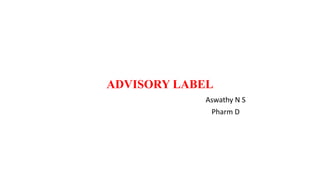Advisory label
- 1. ADVISORY LABEL Aswathy N S Pharm D
- 2. INTRODUCTION âĒ An Auxiliary label or Cautionary and Advisory label (Cals) are sometimes added (with the dispensing label) to a medicine dispensed by the pharmacist to the patient. âĒ Standard cautionary and advisory labels offer advice but are not exhaustive. âĒ The labels are not a substitute for adequate counselling by prescribers and dispensers(most medicines are dispensed by pharmacists) but are intended to reinforce essesntial information the patient needs to know.
- 3. Advisory labels on medication âĒ BEFORE FOOD: To be given atleast half an hour before any food, or two hours after a meal, to ensure the absorption of the drug is not reduced or stopped by the presence of food in the stomach. âĒ WITH OR AFTER FOOD:the presence of food helps to reduce the chance of Sideffects such as indigestion and protect the stomach lining from drugs that may cause ulcers. âĒ SWALLOW WHOLE/DO NOT CHEW: To ensure special tablet coatings are not destroyed before swallowing.These coatings may protect the mouth/throat/stomach from ulcers or reduce the number of times it is administered daily. Anyone chewing this formulations should be prescribed an alternatives
- 4. TWO TYPES OF CALs : ï Providing advice regarding medication use. ïWarning consumers about undesirable effects.
- 5. Recommended label wording can offer advice about ï§ Timing of doses in relation to food. ï§ Completing the course of treatment ï§ What has to be done if a dose is missed ï§ The correct storage of a medicine. ï§ Dissolution of the medicine in water before taking it ï§ Limits to the number of tablets that should be taken in a given time
- 6. Recommended label wording can offer warnings about âĒ Effects of the medicine on driving or work ( drowsiness) âĒ Foods or medicines that should be avoided âĒ Avoidance of exposure of the skin to sunlight or sun lamps âĒ Medicines that can discolour the urine
- 7. THANK YOU






